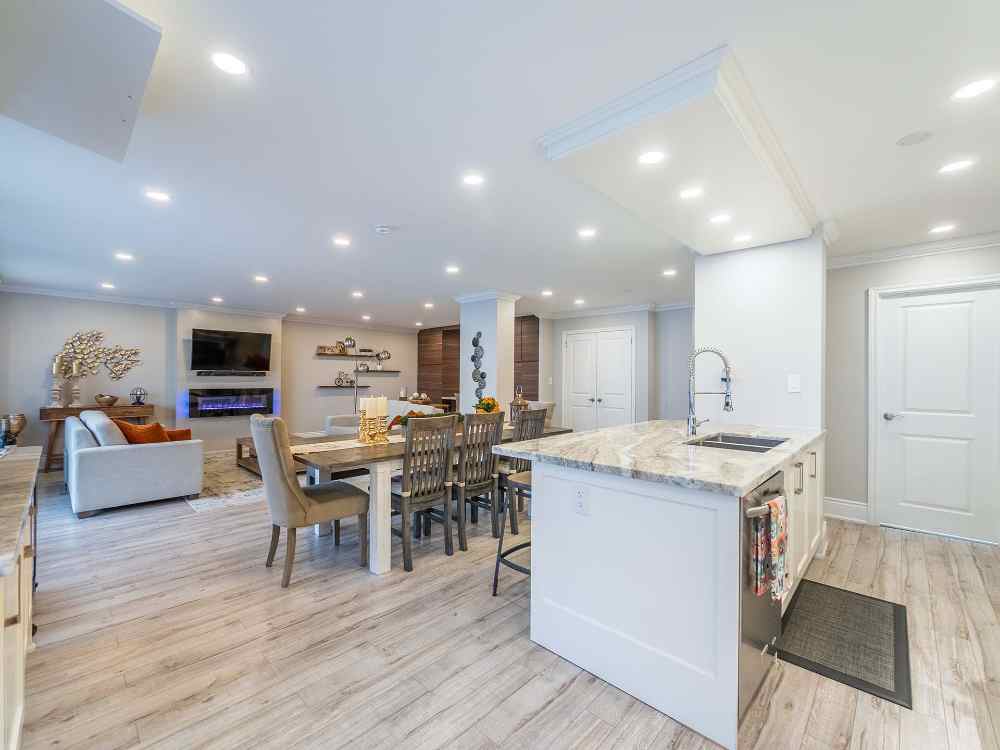When designing a space, it is essential to decide on the feeling or mood that we want to create and home lighting has a lot to do with controlling the mood of a room. Lighting your personal space in a dim or indirect manner will create an environment that will have a relaxed feeling, while white or direct lighting will energize and let us see details more clearly. Our home lighting choices depend on the creative concept we are working on and the room it will be in. Incorporating lighting into our projects is a reflection of the essence of the project and an integral part of the overall design.
The home lighting you choose will affect the mood of a room just and the perceived size of a room. The type of placement is taken into account during the development of an interior design project, and it works in tandem with other design considerations, such as the size of the room, availability of sunlight, and furniture selection. A room’s functionality and style can be enhanced by the right type of home lighting.
Color Management
The use of lighting can add to or subtract from the overall colors of a room or from only those surfaces the light is meant to enhance. Darker colors make a room feel smaller and cramped, while light-colored walls do the opposite. The illusion of space is defined by light reflected off of the surfaces of the walls. Some types of lighting help with this illusion by further illuminating the walls. In addition, directional lighting, such as a track light, can soften the wall colors. There is also recessed can lighting, which has a soft, downward glow that illuminates the floors, not walls. This is opposed to lights hung from the center of the room, which provide ambient illumination, or wall lighting. In both cases, this can affect how light or dark a colored section can appear.
Directional Lighting
Lighting in a room can illuminate the entire space or highlight specific elements. An excellent example of positional lighting is track lighting. The adjustable necks and lamps can be positioned to illuminate specific elements at the bar top or kitchen island, for example, wall paintings, vases of flowers, or the bar top or wall. You might also want to mount them on the walls. Lighting can also be integrated into special picture and mirror frames to highlight certain areas on the wall. Light can be created by recessed fixtures in the ceilings and floors, as opposed to an overall glow from fixtures that hang from the ceiling.
Home Lighting Functionality
Home lighting has a major role to play in interior settings. It is not sufficient to simply light for aesthetic purposes. Besides being the focal point of large, open foyers, entranceways, and rooms, chandeliers also provide excellent illumination for the rooms. An entryway hall will appear longer and larger with wall lights, in addition to lighting the way. Choose the best type of directional or luminescent lighting for your setting by considering the style of lighting. Workstations and workplaces where functionality is most important should have task-specific lighting.

How Lighting Effects Space
It is important to have light in a room, no matter whether it’s natural or artificial. You need to bring in as much natural light as you can into a room that is dark. In the absence of adequate lighting, the room feels cramped. A smaller room makes this situation worse because there are more opportunities for close proximity arrangement, such as a combination of a coffee table, end table, sofa, chair, and love seat. Lighting fixtures hung on the ceiling, corner lamps, wall sconces and wall sconces provide visual light and help to lighten a room that lacks natural light. Whether you are at home or at work, this applies. In a room, natural lighting can enhance the visual space by bouncing off reflective surfaces and showing off colors more effectively. Using sheer drapes and curtains, as well as skylights or large windows, will help you get the most natural light out of your windows.
The importance of lighting within interior design
Consider various types of home lighting that will give you the mood and ambience that you intend.
The lighting of interior space has the power to alter the mood of that space, just as it can alter the perception of its size.
It’s a tricky task, but one that’s essential to interior design, is choosing and locating the right type of lighting. It works in conjunction with other aspects of design, such as color selections, furniture layout and fabric selection. A room can only be harmonious and fluid when all of these elements work together.
It is the reflection of light off surfaces on walls that creates the illusion of space. The walls are further illuminated with certain types of lighting in order to enhance this illusion. Lighting on the wall, for example. In order to light an area properly, a lighting plan should combine all three types.
Accent lighting
The use of accent lighting adds drama and visual interest to a room. It is used in the design of an interior to draw attention to art works, pictures, sculptures, and other valuables. You can also use it to emphasize the texture of a stone wall or window treatments.
It is necessary to illuminate the focal point three times more brightly than the general light that surrounds it for accent lighting to be effective. Recessed lighting and track lighting, as well as wall-mounted picture lights, provide accent lighting. By using a plan, any room or activity will be put in an atmosphere that is perfect for it and, more importantly, offer functionality and practicality for it.

Ambient lighting
Providing an area with overall illumination is ambient lighting. This type of lighting radiates a low-level of brightness, allowing the user to see clearly without glare. Ambient lighting is also used as task lighting in some spaces, such as laundry rooms. It can be done with ceiling or wall-mounted fixtures, chandeliers, track lights and pot lights. Lighting plans should be centered around an ambient source of light in every room.
Task Lighting
Reading, cooking, and working at your desk are some of the things that you need task lighting for. A brighter light is necessary in a smaller focal point of the room is .
Lighting from a distance such as ceiling fixtures can cast troublesome shadows or far too harsh of a light may be better avoided for a more pleasant illumination from a task light. The focal lighting can also be controlled by a single switch, independent of the overall lighting switch.
Here are some common fixture types for task lighting:
- Directional recessed fixtures or pot lights
- Pendant lighting
- Slimline bars or puck lights for under cabinets
- String lights for above cabinets and crown moldings
- Floor Lamps
- Desk lamps
As with all interior renovations, have a plan for your ideas. Lighting adds interest and drama to your interior, intensifying and highlighting the effect and mood you want to create. Brighten up your rooms by using all three layers of home lighting together. Soften the atmosphere by using only one source of light.
Although there are trends in interior design, remember that you have to live in the space you create. Some features, such as floor and window coverings, are easy to change seasonally or as your tastes change. Altering the home lighting is also a good way to freshen an interior. Recovering lampshades or painting a drop lamp can change the look of a room. Let your imagination run free to come up with ideas that transform your living space from ho-hum to wow. It may be as simple as flipping the switch of your home lighting.
Also check out 5 Priceless Tips for Redecorating Your Home After Renovations
Feel free to contact us if you would like some help with your interior design project.

